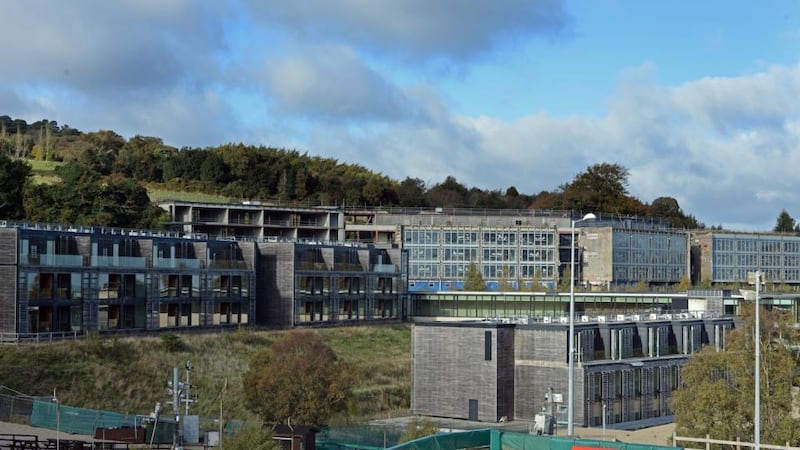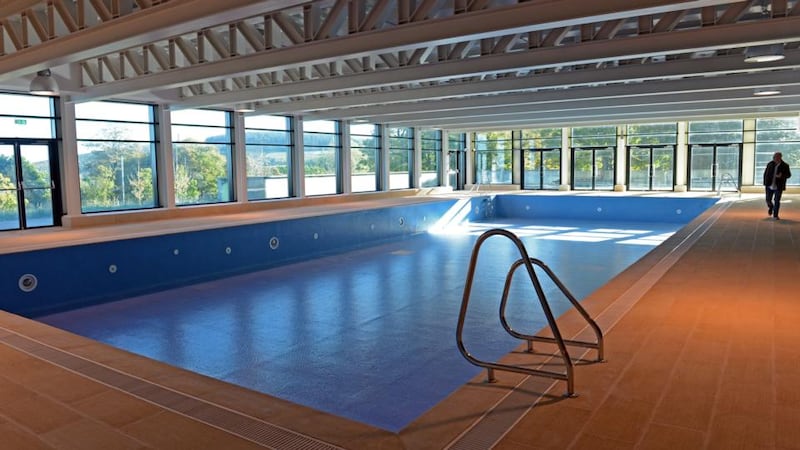Have your say: What should be done with the Kilternan complex - use the comment box below to tell us
On a clear day the views of Dublin from the top of the artificial ski run at Kilternan are stunning but the faraway cityscape draws the eye less now than the low-rise complex of glass and metal planted in the woods at the base of the slope. Sprawling over more than 100 acres, the Kilternan Golf and Country Club should be a hive of activity with guests coming and going and staff rushing to attend the needs of the well-to-do, but this is a hotel with no guests and, apart from a handful of security guards patrolling the perimeter, no staff either. It is a place without a purpose.
The stars came out here once. Back in the 1970s when the hotel in the foothills of the Dublin mountains was a shadow of its current self, Muhammad Ali, Sean Connery and Paul Newman used to walk its corridors and run the long and winding roads that criss-crossed the property.


Today, despite an investment of more than €170 million over two frantic years from 2006, the Kilternan Golf & Country Club Hotel is under the control of Nama and lies empty and idle – a white elephant poignantly emblematic of a Celtic Tiger’s ambitions gone awry.
Some people say this is a cursed place. And well it might be, given the ease and frequency with which it has brought the careers of multiple high-flyers crashing down over the past 40 years.
Everything looked so promising for brothers John and Willie Oppermann and their brother-in-law Joe Wall when they opened the doors of their upmarket country club surrounded by 115-acres of rolling hills and forests here in 1972. Locals bought into the concept with almost unseemly haste and it quickly became a boozy bolt-hole for the well-heeled denizens of south Co Dublin. But before the Oppermanns could get used to their new-found status as country club elite, their luck deserted them. After just a year, a promised investment from an American backer went south and their club fell into the hands of a receiver.
Locals, dismayed by the prospect of losing their club and all the cachet and chicken cordon bleu that came with it, tried to buy the property and keep the doors open. They got the readies together but were outbid by Pat Quinn of Quinnsworth. He bought the place for £500,000 in June 1973 and set about spending £400,000 on re-developing it as a social and sports club to be known as the Pat Quinn Club. It wasn’t to be known as that for long though, and less than a year after he cut the ribbon on his vanity project, Quinn’s tenure was over and his club was wound up with liabilities of £1 million.
It was then resurrected as the Dublin Sports Hotel before being taken over by a Hong Kong-born businessman Raymond Tsan in the early 1980s. He paid £1.2 million for the property and, like Quinn before him, spent £400,000 on a refurbishment. It failed again and by 1987 it was back with the receivers. It changed hands several times before eventually finding its way to Hugh O’Regan.
During the boom’s first act, in the late 1990s and early 2000s, O’Regan, made millions in the pub trade. He sold his Thomas Read Group of fashionable super-pubs for €30 million just over 10 years ago when not yet 40, and then the likeable and almost universally popular publican took a well trodden path and turned developer by reinvesting his fortune – and then some – into a wildly ambitious scheme to reshape Kilternan.
He had bought the hotel and the land around it for €12.7 million in 2001 and set about transforming it from a small and tired hotel into a sprawling leisure and learning campus that would be unrivalled in the Republic.
Filled with energy and enthusiasm, he pumped an estimated €170 million into redeveloping the place into an eco-friendly hotel and apartment complex. There was to be organic restaurants, TV studios, swimming pools, indoor tennis courts and a golf club. And a whole lot more besides.
Then, in 2008, when O’Regan’s dream was just about to come true, the banking crisis hit. The money tree that had been planted by Anglo Irish Bank and Michael Fingleton’s Irish Nationwide, withered. The last tranche of cash O’Regan needed to finish the hotel was withheld and the two banks pursued him for debts totalling €172 million and €80 million respectively.
Just under a year ago, aged just 49, O’Regan died.
Much of his legacy is still in place and is being protected with almost paranoid zeal by Nama-appointed receivers from EY (formerly Ernst & Young) who only gave The Irish Times limited access to the property earlier this week after protracted negotiations over several weeks.
The cracks appear
From a distance, the complex looks finished, with the gleaming glass panelled facade of the leisure centre and the hotel shimmering in the late autumn sunlight. Close up, though, the cracks appear quickly, first in a wattle wall surrounding the property where the loose twigs are slowly fraying and coming undone and then in a more pronounced way in the nearby apart-hotel which is nothing more than a building site with a pretty face.
But there are elements that are a whole lot more than a pretty face. First is the leisure complex, which is 95 per cent complete. All that is missing from the 25-metre pool, which has been fully tiled in aqua-marine, is the chlorinated water, while the racing green-coloured sauna would be good to go with a whiff of steam.
The large conference room that takes up much of the space on the floor above the pool is empty but for a rack of six chef’s whites in varying styles. They hang there, limply, waiting for someone in authority to choose which of them will be used by the hotel’s cooks. It is a choice which will never be made now.
The room next door to the conference room is laid out like a boardroom but instead of hosting the captains of industry, as was the plan, the seats are now only ever occupied by creditors chasing their capital – occasional meetings are still held here for this group but as the years pass, the numbers who bother showing up have dwindled. The leisure complex is also home to a vast shed of red corrugated iron where three indoor tennis courts were supposed to go, and across the empty carpark is the function room which was supposed to be hosting wedding parties for in excess of 200 people every weekend.
A small wooden door from this large room leads to the old house where cavernous echo chambers are replaced by cosy small rooms with sash windows and marble fireplaces.
The old quickly becomes the new again and a 129-room hotel of sweet-smelling wood, polished stone and green-tinged glass has been tacked on to the side of the old house.
As with the leisure centre, the hotel is over 90 per cent complete. It is nearly finished. And it is sad. Walking the corridors feels like walking through someone’s broken dreams. The bedrooms look small and claustrophobic, even when empty, and while they were tastefully done up to the highest spec in 2007 with brushed chrome light switches and plug sockets, gunmetal grey heaters and beech wood shelving, fashions change. the decor is starting to look a little tired.
The hotel has two kitchens, both fitted with cold rooms, huge vents and complicated lighting arrangements – all they are missing is the food and the people to cook it. Both the bar and the restaurant have wall-to-ceiling windows and both have been fitted with baker’s ovens which were supposed to provide the kitchens with freshly baked bread and the diners and drinkers with pleasant aromas throughout the day.
The outdoor terrace, with its stunning views of the mountains and the Kilternan Ski School which brushes against the perimeter of the property, is just the kind of place you’d like to have an early evening drink until you look beyond the edge of the terrace at the tangle of cables, broken wood and the other detritus left behind by builders forced to stop work overnight after the banks shouted stop.
Kilternan has been on the market for years now and while a handful of potential bidders have had a look, there has been no serious interest. The cost of upkeep and security makes a sale increasingly pressing and while the receivers are reluctant to say how much they would accept today, industry sources say Nama would bite the hand off anyone who bids close to €50 million.
EY, which looks after the property, says that a prospective hotelier taking over the whole property would be the most desirable outcome, but it is also open to selling off the property in pieces and has suggested that in addition to a hotel the property could be repurposed as a corporate headquarters or accommodation. It was also mooted at one point that the complex be converted into a university halls of residence – although given the distance from any such institution, this notion may be fanciful.
Given that the complex is owned by the people of this State, perhaps it would be best if they had a say in what was to become of it?
And who knows, maybe if we worked on a plan together we could come up with a resource that would breathe life into the local community and the country and help to break the Curse of Kilternan into the bargain.










